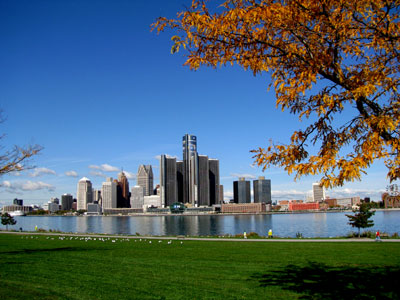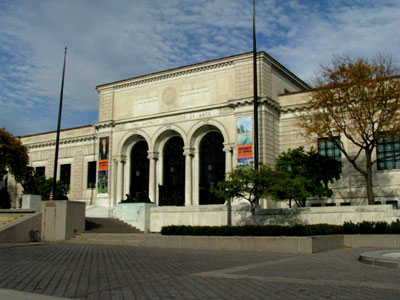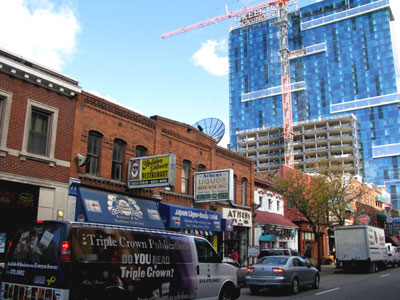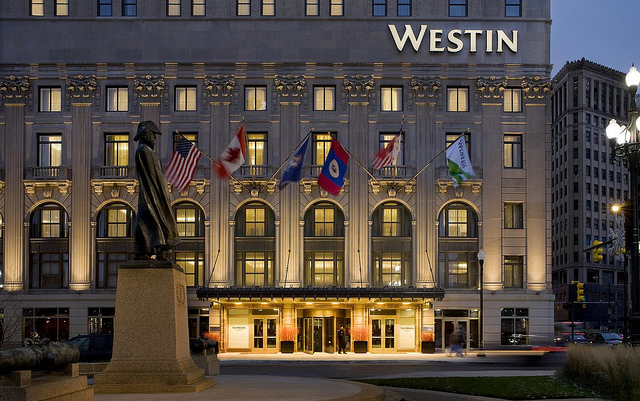The southern end of the cathedral-like space features an oversize mural with a map of Michigan. Today this space is used as a retail space as the current owners decided that it was important to turn this area back into publicly accessible space. What a great move for architecture lovers! I am glad they did; as you can probably tell, the Guardian Building had quickly became my favourite. A coffee shop anchors the centre of the former banking hall, and we ended up chatting to Shawn Santo, the café’s proprietor who also owns the Pure Detroit retail store on the east side of the building.

The Guardian Building – truly the “Cathedral of Finance”
Leaving the Guardian Building behind, we strolled south to Hart Plaza, Detroit’s Civic Centre, also the location of the 1701 landing of Antoine de la Mothe Cadillac, the founder of Detroit. This French explorer played an important role in the history of New France when he landed on the shores of the Detroit River and founded a settlement by the name of Fort Ponchartrain du Détroit. The word “Detroit” itself is derived from the phrase “le détroit du Lac Érie – the strait of Lake Erie”. By 1765 Detroit was the largest city between Montreal and New Orleans. Detroit changed hands from the French to the British in 1760, and then from the British to the United States in 1796. Lots of history unfolded right here, in the area of today’s Hart Plaza.

The Joe Louis Fist Sculpture
Approaching this space I was impressed by a giant suspended fist – the Joe Louis Fist Sculpture, created by artist Robert Graham to honour Detroit’s legendary boxer Joe Louis. The hard-surface open area of Hart Plaza holds a number of outdoor installations: a giant circle-shaped monument to the labour movement features quotes by famous labour and human rights leaders including Nelson Mandela as well as a fountain dedicated to Horace E. Dodge.

The Labor Monument on Hart Plaza
Sitting next to the walking path on the river’s edge is the Underground Railroad Memorial, “Gateway to Freedom”, designed by sculptor Ed Dwight and dedicated in October of 2001. Ed Dwight himself is an interesting story: a former Air Force Test Pilot, he is also America’s first African American Astronaut Trainee as well as a successful entrepreneur. Dwight’s sculpture highlights that Detroit was an important site in the Underground Railroad, the network of secret routes and safe houses that took 19th century African-American slaves to freedom. A similar statue by the same artist is located on the other side of the Detroit River, in Windsor, Canada. Detroit was an important point of debarcatation for thousands of enslaved Africans in their quest to escape to safety and freedom.

“Gateyway to Freedom” commemorates the Underground Railroad
Heading back into the city from the waterfront we passed by the “Spirit of Detroit”, a large bronze statue that was dedicated in 1958. This statue is often dressed up in sports jerseys when Detroit’s professional sports teams make it into the playoffs. Up the street on Woodward Avenue is Campus Martius Park, one of Detroit’s most popular outdoor spaces since its opening in 2004. Local residents had expressed a strong desire for a greenspace in downtown Detroit, particularly since Hart Plaza is a primarily hard-surfaced area.

Spirit of Detroit
A Michigan Soldiers’ and Sailors’ Monument anchors the south side of Campus Martius Park; the centre holds a café, outdoor seating and a green space that is used as a skating rink in the winter. The north side of Campus Martius Park is highlighted by the new Compuware Headquarters which opened in 2003. Compuware, one the USA’s most important software firms, relocated its head office to its new location, a successful example of business relocation into the downtown financial district.

Campus Martius
From here we headed to the lobby of the David Stott Building, another Art Deco skyscraper dating from 1929. Designed by Donaldson and Meier, its 37 stories feature a reddish granite base, brick, marble and limestone as well as sculptures by Corrado Parducci. We then crossed over to Washington Boulevard where we walked north past several historic buildings, including the headquarters of the Archdiocese of Detroit and a Catholic church built in 1930.

The historic Book Tower on Washington Boulevard
At the north end of Washington we saw a grouping of historic skyscrapers including the recently renovated Kales Building, the David Broderick Tower and the David Whitney Building, many of which have been converted into apartments. This area also used to be the home of the renowned Statler Hotel and the Hotel Tuller which were demolished in 2006 and 1992 respectively. Because of its many abandoned and demolished buildings this area is often referred to as “skyscraper graveyard”.

Three early 20th century beauties
After concluding our downtown tour Bob and I drove a few minutes east to the Eastern Market, Detroit’s historic market near Gratiot and Mack Avenues. The first farmer’s market in Detroit was opened in 1841 downtown, and additional markets were opened in the 1850s, including one on the site of the current Eastern Market. The current outdoor sales sheds date back all the way to 1891 while the surrounding brick Victorian buildings house many additional food and other retailers. Today, the Eastern Market is the largest historic public market district in the United States.

Detroit’s Eastern Market
This Saturday morning the Eastern Market was hustling and bustling, and all sorts of produce, meat, spices and other products were on sale. On average the market attracts 45,000 locals and out-of-towners every Saturday. A cooking demonstration was underway and several musicians were performing live for the crowds. Halloween pumpkins, gourds and chrysanthemums were on display everywhere, providing a colourful reminder of the fall season.

The bounty of the fall harvest
Following our brief visit to the market Bob dropped us off at the Bucharest Deli where we had a delicious lunch with chicken and bean soups and vegetarian shawarmas. Appropriate strengthened after a tasty meal, we were ready for our next adventure: a walking tour of Brush Park, a historic neighbourhood in transition.




